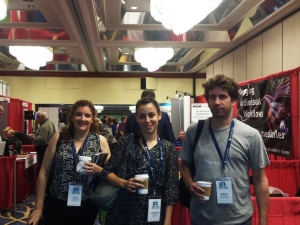As Melissa mentioned in a previous blog, I am the 2014 Audiovisual Preservation Lennox Intern. My area of expertise is not books or paper, but I still deal with objects from the past that are part of our cultural heritage and that we must conserve, preserve, and when necessary (and possible) restore. Even when paper conservators and film preservationists do not communicate with one another, their work has more in common than most of them probably suspect.
Breaking down those barriers is one of my goals during my internship at the ISU Library. I hope to bring more thoughts and anecdotes about my work in a future post, but today I would like to tell you about my experience at the AMIA Conference 2014, held in Savannah, GA, on October 7th-11th.
The Association of Moving Image Archivists (AMIA) has been working for several decades representing over 750 audiovisual archivists from all over the world. Since 1991, AMIA has formally been an individual-based professional association, unique in the field, providing representation and camaraderie not only to institutional archivists, but also to students and recent graduates.

Every year we gather in a beautiful city (Savannah, GA this year) to share experiences, exchange different opinions, raise questions, and learn from one another’s work. The AMIA conference is a great place for new film archivists to learn and network. It is also a great opportunity for conservators, archivists, and librarians that have film collections in their care to learn the basics, ask questions, and make contacts that might come in handy when dealing with special materials.
There are traditional topics that are always candidates for panels and discussions, such as acetate and nitrate deterioration, best practices, the unknown future of digital collections, and the transition from film to digital, among others. This year, the conference presented three curated streams of programming that analyzed matters that are of most interest in the present days.
The first one was “Open Source Digital Preservation and Access” which covered the basics of open source software for audiovisual collections management and highlighted some relevant current projects.
The second program (my favorite) was “Film in Transition,” which discussed the implications that the evolution of the industry — from film to digital — has for film archives and everyone who still needs to work with film stock. Basically, the question was: will archives will be able to continue to preserve films with so many labs closing and such a limited production of film stock?
Last but not least, the third stream was entitled “Global Exchange,” and brought voices from all over the world to share solutions and exchange ideas. This year I was very happy to see a panel discussing the activities in the South American archives, and particularly the staff from Museo del Cine de Buenos Aires (Buenos Aires Film Museum), the most important film archive from Argentina, my home country.

To conclude, there were two special moments that were my favorite. The archival screening night at the marvelous Lucas Theater, in which archives were invited to share a 6-minute clip from the treasures of their collections. I would very much like to see something from the ISU Film Collection next year! Last, the obsolete film formats panel, where they presented the smallest film gauge ever used, 3mm, the cutest medium ever!

For more information about the event, visit the conference website.
For more information on film preservation, visit the National Film Preservation Foundation.